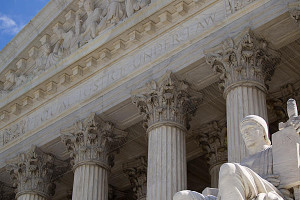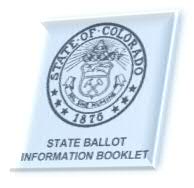by Sharon Eubanks
If a legislature does not have the power to impose new taxes or raise the amount of existing taxes, does the state enjoy a republican form of government? Some think not.
 In late May of 2011, 34 plaintiffs, including members of the General Assembly, local government officials, educators and education officials, and citizens of Colorado, filed a lawsuit against Governor John Hickenlooper in his official capacity and the State of Colorado in federal District Court for the District of Colorado. The lawsuit is entitled Kerr v. Hickenlooper because Senator Andy Kerr, one of three current legislators who are plaintiffs, is the first plaintiff listed on the complaint.
In late May of 2011, 34 plaintiffs, including members of the General Assembly, local government officials, educators and education officials, and citizens of Colorado, filed a lawsuit against Governor John Hickenlooper in his official capacity and the State of Colorado in federal District Court for the District of Colorado. The lawsuit is entitled Kerr v. Hickenlooper because Senator Andy Kerr, one of three current legislators who are plaintiffs, is the first plaintiff listed on the complaint.
The plaintiffs allege that the Taxpayer’s Bill of Rights (TABOR), Section 20 of Article X of the Colorado Constitution, violates the Guarantee Clause and the Equal Protection Clause of the United States Constitution and section 4 of the Colorado Enabling Act of 1875 by eliminating the General Assembly’s plenary power to legislate on matters of taxation and appropriations and thereby denying the state of Colorado and its citizens an effective representative democracy. As part of their claims, the plaintiffs argue that TABOR has inflicted an institutional injury upon all members of the General Assembly by removing their ability to enact taxes to provide for the state’s expenses, thus rendering the General Assembly unable to effectively fulfill its legislative obligations in a representative democracy and a republican form of government.
In response to this lawsuit, the Attorney General filed a motion on behalf of Governor Hickenlooper in mid-August of 2011 asking the federal District Court to dismiss the lawsuit on several procedural grounds, including: 1) plaintiffs’ claims constitute nonjusticiable political questions that neither the federal District Court nor any other court can resolve on the merits; and 2) even if these questions could be resolved, the plaintiffs lack standing to bring the lawsuit. In July of 2012, the federal District Court denied the Governor’s motion to dismiss on all grounds except the Equal Protection Claim.
The Governor appealed the federal District Court’s order to the federal 10th Circuit Court of Appeals. The appeal was assigned to a 3-judge panel of the 10th Circuit, which affirmed the federal District Court’s order. Next the Governor filed a petition for rehearing before the entire membership of the 10th Circuit Court of Appeals. The court denied the petition for rehearing en banc, and the Governor filed a petition for writ of certiorari appealing the federal District Court’s order to the United States Supreme Court. After both parties and several amicus curiae (“friends of the court”) filed briefs on the petition, the matter was scheduled for discussion at the January 9, 2015, conference of the Supreme Court Justices.
The Justices’ conference is a private meeting of the Supreme Court Justices to discuss a short list of cases they are considering for review. The Justices’ decision to grant or deny review is usually announced shortly after the Justices’ conference. However, in this case, the Supreme Court did not immediately announce any decision as to whether the Supreme Court would hear the appeal of the procedural issues raised in Kerr v. Hickenlooper.
Some speculated that the Supreme Court was waiting to announce its decision until after the Court issued its decision in another case it heard this term – Arizona State Legislature v. Arizona Independent Redistricting Commission et al. In this case, Arizona’s Legislature challenged the constitutionality of a redistricting commission created by ballot initiative to draw congressional districts. One of the issues raised in the Arizona State Legislature case is whether the Legislature has standing to bring the lawsuit, so the Supreme Court’s decision in this case could have implications for the Legislator-Plaintiffs’ standing in Kerr v. Hickenlooper. It turns out that this speculation was correct.
this case could have implications for the Legislator-Plaintiffs’ standing in Kerr v. Hickenlooper. It turns out that this speculation was correct.
On June 30, 2015, the last day of the Supreme Court’s October 2014 term, the Supreme Court issued a grant, vacate, and remand (GVR) order in Kerr v. Hickenlooper, which granted the Governor’s petition for writ of certiorari, vacated the decision of the 10th Circuit Court of Appeals, and remanded the matter back to the 10th Circuit for reconsideration in light of the Supreme Court’s decision issued the day before in Arizona State Legislature. In that decision, the Supreme Court held that the Arizona Legislature, as an institution, has standing to challenge the constitutionality of the redistricting commission even though the Supreme Court also upheld the constitutionality of the redistricting commission.
As a result of the Supreme Court’s GVR order in Kerr v. Hickenlooper, the 10th Circuit has established July 31, 2015, as the deadline for parties and amicus curiae to file supplemental briefs on the impact of the Supreme Court’s decision in Arizona State Legislature on the issue of the Legislator-Plaintiffs’ standing.
Watch for further developments in this lawsuit.














